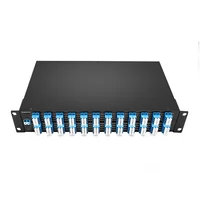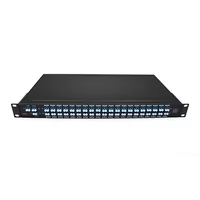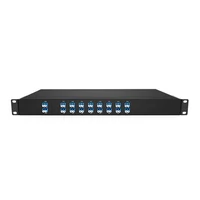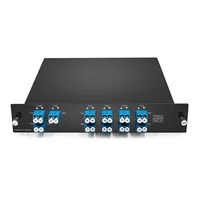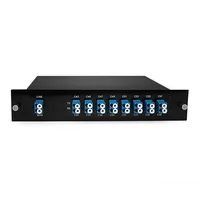Dense Wavelength Division Multiplexing (DWDM) innovation has transformed the sector of fiber optic networks by allowing the transmission of several data streams in one optical fiber, thus increasing the channels that DWDM can accommodate. This improvement is crucial for telecommunication and data center industries, where the requirements for bandwidth are continually on the rise. This system incorporates several custom-manufactured devices whose combination allows one to implement high-capacity data transmission and delivery even over long distances without damaging signal quality. Such devices include but are not limited to transponders, optical amplifiers, multiplexers, and demultiplexers; all these devices assist in effectively controlling light signals. In addition, there is enormous room for managers to influence system performance through DWDM, improving system throughput and utilizing available systems, especially in cases when single wavelengths are required. In this regard, this paper examines the components of DWDM equipment, its advantages for building new networks, and its use in existing networks.
Table of Contents
ToggleWhat is DWDM Technology?

Dense Wavelength Division Multiplexing (DWDM) is one of the most advanced ways of sending data through a single fiber optic member with many data channels using different light wavelengths. It improves the capacity density of the fiber input and its diversity, enabling quick data boost, which forms the basis of contemporary communication networks and data centers. Each channel is on a separate wavelength, making it possible to transmit massive volumes of information simultaneously without affecting each other. It forms an essential basis for fast, reliable communication over any set distance, elongating the infrastructure while fewer additional fibers are needed.
Understanding Dense Wavelength Division Multiplexing
Dense Wavelength Division Multiplexing (DWDM) requires the cooperation of several essential components to achieve its sophisticated utility in optical networks. These devices adapt electrical signals, such as voice or video, into optical signals and translate the desired signal onto a specific wavelength. Muxes are devices that combine the transmission of different wavelength optical signals onto a single fiber core, thus enabling the use of care & attention to each DWDM wavelength. On the other hand, demultiplexer basics take an incoming composite optical signal and disperse it to individual wavelengths to be further used or transmitted. All the abovementioned processes and devices interoperate effectively to maintain signals and optimize the structure of fiber optics; hence, it allows communication of large volumes and is highly expanded on DWDM as a standout feature.
The Role of Wavelength in DWDM Systems
These DWDM systems assign a specific wavelength for each data channel; this makes it easy for the system to operate effectively as they each correspond to the C-band or L-band spectral range, which optical amplifiers perform well in. By using closely spaced wavelengths, a significant amount of data can be transmitted on a single fiber, improving overall system capacity. This careful management of wavelengths is necessary to avoid their overlap and interference in the transmission system for passing information over many channels efficiently and with high quality. The development of fine-tunable and controlled wavelengths allows the expansion of telecommunications networks, which are reliable and scalable simultaneously and will enable them to cope with the constantly growing demand for data.
Essential Components of a DWDM System
The most basic units in a DWDM system are optical transponders, multiplexers, demultiplexers, and optical amplifiers. With transponders, electrical signals are transformed into optical signals with the proper wavelengths to make it possible for the DWDM to function. Multiplexers are used in optical communications where numerous signals on different wavelengths are combined into one fiber to use data bandwidth effectively. Demultiplexers do the opposite; they separate the combined optical signals from the optical fiber into their component distinct signals for further treatment. Erbium-doped fiber Amplifiers (EDFA) are optical amplifiers that raise signals’ strength over long distances without converting them back into electrical forms. These elements guarantee sufficient high-capacity channels for effective broadband data transfer across the optical system.
How Do DWDM Components Work Together?

Function of the DWDM Multiplexer
A Dense Wavelength Division Multiplexing (DWDM) Mux – connects several devices transmitting at different wavelengths onto a single fiber optic cable received through multiple fibers – enabling expansion and enhanced optical communication systems bandwidth. Combining various signals from different fibers into one cable would be central to the usage of DWDM. The active filtering characteristics and the quality of the used fibers achieve the required degree of separation between the channels. Each data channel is transmitted at the focal point at different frequencies. In telecommunications, DWDM makes it possible to use large volumes of data through multiple wavelengths on a single fiber cable, contributing to the global surge in data traffic within the network of telecom systems.
Transponders and Optical Signal Transmission
In the case of Dense Wavelength Division Multiplexing (DWDM) systems, transponders act as crucial intermediates between the client input and the optical network. In a fundamental form, a transponder receives a data signal from a client and transforms it to be compatible with the optics infrastructure. This usually consists of a client’s equipment’s electrical signal being converted into an optical signal. The transponder allocates a specific wavelength for each outgoing channel, which is further multiplexed into the fiber by the DWDM MUX. At the other end, a transponder does the reverse; it receives the multiplexed optical signal, separates them into various electrical signals, and sends them out to the clients as long as the relevant DWDM wavelengths are correctly aligned. Transponders play a vital role in maintaining the consistency and timing of the data within the network, enabling the wide-area reliable transfer of the optical signals.
Utilizing Optical Amplifiers in DWDM Systems
Optical amplifiers are essential for improving the performance of DWDM systems at long distances without having to convert optical signals into electrical and then back into optical signals. The most common ones are Erbium-Doped Fiber Amplifiers (EDFAs), which work best with the DWDM systems operating in the C and L bands designated for long-distance voice communication. With the help of the high gains and output power they provide, EDFAs can strengthen signal strength so that it is possible to increase distances without compromising signal quality. Raman amplifiers may also be employed as a supporting technology that provides gain while utilizing transmission fiber as an interaction medium with the light transmitted through it, improving DWDM device performance. All these allow the DWDM systems to communicate and process vast volumes of data over large distances and, most importantly, with satisfactory signal distortion and attenuation. Bandwidth requirements of the telecommunication infrastructure of the new generation are met.
What are the Benefits of DWDM Technology?
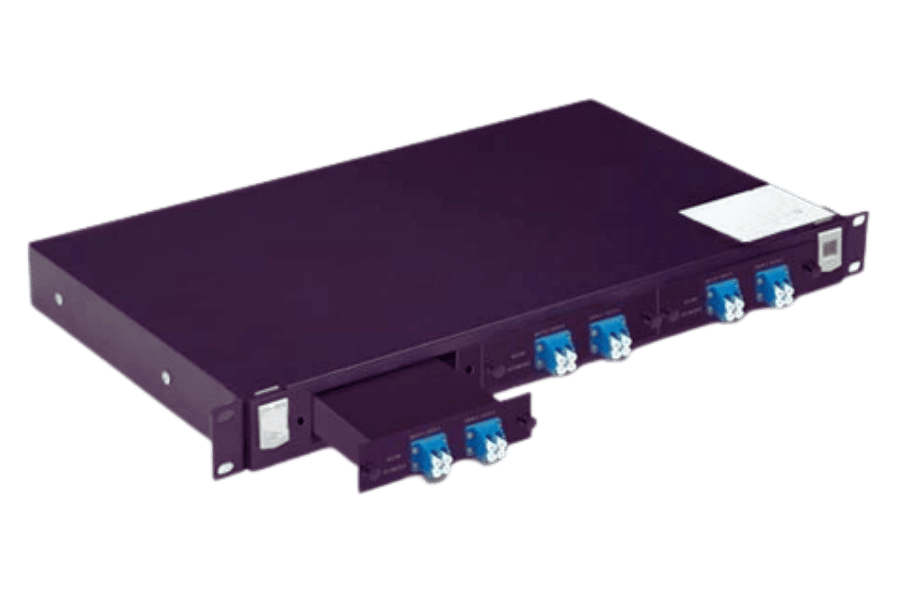
Enhancing Bandwidth with Multiple Wavelengths
DWDM technology increases bandwidth substantially by incorporating optical multiplexing using various wavelengths for every channel. This approach increases the fiber capacity by many folds without additional fiber cables. DWDM can accommodate up to 160 channels in a single optical fiber by combining the possibilities with 10 Gbps data rates or more. This way, telecom providers can answer the increasing need for high-data-rate services without deploying new cables. Furthermore, DWDM allows for expanding existing network architectures since it provides considerable savings in the construction and maintenance costs of WANs.
Advantages of Using DWDM in Metropolitan Networks
Dense Wavelength Division Multiplexing (DWDM) technology benefits metropolitan networks, emerging from the best available literature. First, DWDM is very flexible as it enables networks to meet increasing data needs by adding or removing wavelengths as required without much makeover. Secondly, it optimizes existing port use and supports high data concentration. This seems crucial as it enables one to maximize the use of already laid out fiber infrastructure without the need to lay new cables. WDM has a high integration capacity, which significantly decreases the cost and complexity of network implementation, especially during the integration of several WDM devices. Last but not least, DWDM systems maintain adequate transmission quality and allow extensive system spans with minimal data or information loss, which makes it easy to provide high-speed Internet and other communication systems across urban areas. Accordingly, such characteristics justify its attributes as necessary in developing metropolitan networks to speed up bandwidth requirements.
How DWDM is Cost-Effective for Data Centers
Dense Wavelength Division Multiplexing (DWDM) can be considered an important factor in improving the cost-effectiveness of data centers. To begin with, DWDM optimizes the use of the existing fiber facilities by allowing many data channels over one fiber, thus avoiding the need to lay more fibers. This in-built scalability facilitates quick response to heightened demand for data without necessarily incurring heavy capital investment in infrastructure. In addition, DWDM enables long-distance optical transmission with little signal loss. Hence, the need for more amplifying devices and maintenance is less, decreasing operating costs. Cost-effective high bandwidth consolidation enables DWDM to ensure that data centers cope with increased data traffic cost-effectively, which makes DWDM an essential tool in addressing network costs.
What Are the Key DWDM System Components?
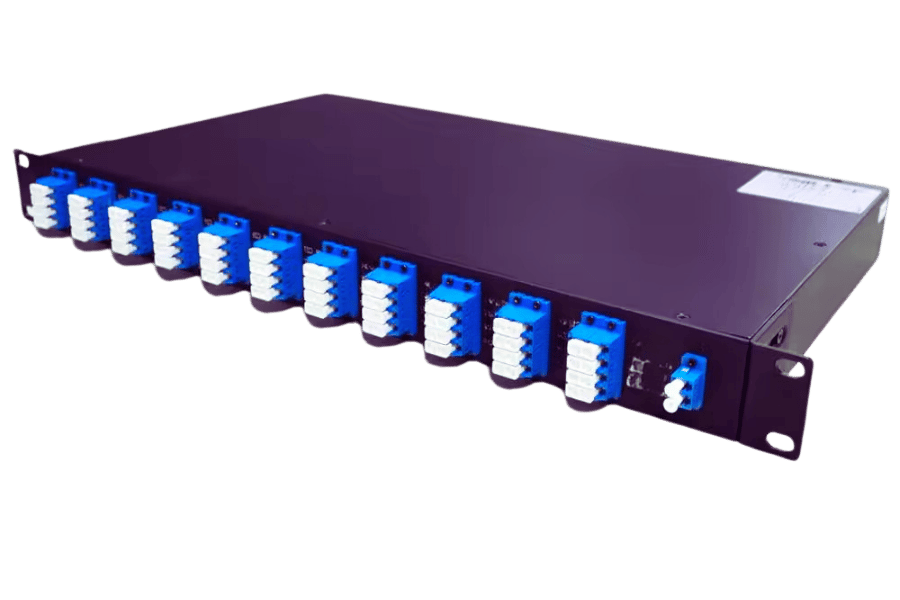
Role of DWDM Transceivers
From my professional perspective, DWDM transceivers are essential to the operation of DWDM systems. These units convert electrical impulses to light signals at a particular wavelength, crucial in combining many data channels into a single optical fiber. Thanks to wavelength precision techniques transceivers apply, data integrity mangles cross-channel interferences. Also, these devices are crucial in enabling the convergence of different types of networks since they also support single-mode and multi-mode fibers, increasing the flexibility and compatibility of the DWDM system.
Understanding Optical Line and OADM
Based on my thinking about the optical line characteristics and OADM, they seem to be the key elements for data transmission. An optical line is a transmission medium that transmits multiplexed signals from one point to another using fiber optics to provide a large bandwidth pipeline. Conversely, the OADM is used to add or remove specific wavelengths of light while keeping the other wavelengths unchanged. This function is essential for the management of a network, as it allows the changing of data paths and hence improves the use of the bandwidth. The use of these technologies in a single DWDM system increases the functionality of the networks and the efficiency of the optical communication infrastructures.
What Are the Applications of DWDM?

DWDM in Optical Networks and Metro DWDM
Dense Wavelength Division Multiplexing (DWDM) technology addresses bandwidth limitation problems in telecommunication networks. On the other hand, Enhanced Throughput with geographical constraints without provision of more fiber facilities is possible with the usage of D.W.D.M. Enhanced transmission systems such as optical fiber in the DWDM technology increases the bandwidth span further and advanced network design aids in supporting high demand for data services. With bandwidth shortage, Dwdm technology can be used for the optical network over longer distances without damaging the integrated channels. Dwdm technology has changed the whole telecommunication method by super long-haul cable applications.
Implementing DWDM Solutions for Existing Fiber Optics
Integrating DWDM (Dense Wavelength Division Multiplexing) solutions into already deployed fiber optic networks takes careful consideration of several technical and strategic aspects. According to the Provider, the primary steps include carrying out a widespread evaluation of the network to identify the existing weaknesses and strengths of the current infrastructure. This evaluation supports constructing how much the existing fiber can accommodate and what specific DWDM equipment will be necessary to enhance this capability. Then, appropriate transponders and multiplexers must be obtained to source DWDM equipment that would support the needs of the network without disturbing the existing structure.
Furthermore, future use of the network should be noted while integrating DWDM. This means not only replacing the physical components but also applying intelligent management systems that will cope successfully with growing volumes of traffic and will stand up to different tasks within DWDM applications. Employing lightweight, modular implementation techniques to modify already deployed DWDM may make such changes more accessible and less disruptive. Also, maintenance and monitoring resources must be planned and allocated sufficiently to increase the network’s efficiency and extend the network systems’ resources- especially when there is a high demand for DWDM applications.
DWDM Solutions for High-Density Data Transmission
According to the best authorities on the issue of DWDM solutions, the use of Dense Wavelength Division Multiplexing is beneficial in cases of high-density data communication primarily for some critical reasons. First, DWDM can enhance the capacity of existing fiber optic systems many fold without necessitating the laying of more fibers, thus allowing the sending of several data streams simultaneously. This feature resolves the increasing requirements of the transmission traffic brought about by the current applications and services.
In addition, DWDM is recognized for its expansion and configuration potential. Its effectiveness in supporting more wavelengths allows network operators to increase capacity in small steps, guaranteeing that the structure will be equipped for the future increasing amount of data. Such expansion potential is very important for telecommunications companies, allowing them to stay competitive and manage their expenses.
Finally, DWDM’s strong complaint resistance and dependability are crucial in high-density data settings, which is why it is suitable for many DWDM applications. DWDM Centric Active Optical Networks use dedicated wavelengths for primary communication, reduce interference and other failure modes through direct data transfers, enhance network performance, and consistently transfer data. These features make DWDM solutions an integral part of all operators and service providers that seek high reliability, density, and growth potential of the networks.
Reference Sources
Wavelength-division multiplexing
Frequently Asked Questions (FAQs)
Q: Briefly explain Dense Wavelength-Division Multiplexing (DWDM) and its differences with WDM.
A: Dense Wavelength-Division Multiplexing (DWDM) is a more complex optical system that enables sending multiple optical data channels through a thin layer of fiber using different wavelengths of light. DWDM differs from standard WDM in that it can have more channels and maintain the transmission of more data over longer distances at a lower insertion loss.
Q: What is a DWDM tunable device, and how does it work?
A: Signals at various wavelengths can be transmitted by tuning the transmitter in a DWDM tunable device. This helps optimize the bandwidth consumption available, assists in the network’s automated control, and makes the network agile enough to respond readily to data traffic changes or when new channels need to be included.
Q: Are any specific industries using DWDM technology in their optical networks?
A: There are many potential uses of DWDM technology, for instance, in telecommunication with large capacity, data centers, and even broadband access networks. This is because DWDM can transmit fibers over long distances unaffected by distortions. It also increases the capacity of service providers by allowing a single fiber to transmit many data streams at a time.
Q: What are the critical components of DWDM equipment?
A: Key components of DWDM equipment include DWDM transmitters, receivers, mux and demux (multiplexers and demultiplexers), and optical fibers. These components unite and operate to send and receive adjacently spread signals across a specific bandwidth, thus increasing the amount of information transmitted over a single fiber optic network.
Q: Why is DWDM considered advantageous for transmitting large amounts of data?
A: DWDM is advantageous for transmitting large amounts of data because it can carry several channels over one fiber, each operating at a different wavelength. This, in turn, increases the bandwidth capacity of the fiber. As a result, large quantities of information can be transferred simultaneously using the same fiber optic cable without adding or deviating from other fiber optic cables.
Q: How does the introduction of DWDM impact existing optical networks?
A: Introducing DWDM in existing optical networks greatly enhances their capacity and efficiency, for instance, about the 100G DWDM applications. It has been noted that there is no need to construct additional networks to the existing ones as the capacity of these networks, with the addition of the DWDM technique, allows for carrying more data, making the cost of expanding these networks relatively low.
Q: In your opinion, how significant is the technological concept of insertion loss in DWDM systems?
A: The term “insertion loss” describes the reduction of signal transfer power that occurs when a signal passes through a device, such as a mux or a demux, in DWDM systems. A tactical approach to improving the insertion loss in this scenario is necessary to ensure that the signal is transmitted over long distances and of good quality.
Q: Explain the function of a DWDM mux.
A: The DWDM mux, or multiplexer, allows for the combining of more than one DWDM signal, which is on various wavelengths, onto one optical fiber for transmission. Such a practice ensures that the operational bandwidth within the fiber is efficiently used while using an optimal number of fibers.
Q: Switch to the sending site and explain how the demultiplexing of the DWDM signal is done there.
A: In DWDM systems, the demux converts multiple wavelengths of the received signal to separate ones, thus receiving the isolated signal for data processing. The relevance of the unitary diversity of signal when carrying out transmission tasks comes to light when using a demux toward the completed DWDM signal, which allows each data channel to be directed toward its respective receiver.
Related Products:
-
 DWDM MUX DEMUX 50GHZ 96CH (C15-C62) LC/UPC Dual Fiber 2U Rack
$6000.00
DWDM MUX DEMUX 50GHZ 96CH (C15-C62) LC/UPC Dual Fiber 2U Rack
$6000.00
-
 DWDM MUX DEMUX 40CH (C21-C60) LC/UPC Dual Fiber 1U Rack
$1100.00
DWDM MUX DEMUX 40CH (C21-C60) LC/UPC Dual Fiber 1U Rack
$1100.00
-
 DWDM MUX DEMUX 16CH (C21-C36) with Monitor Port LC/UPC Dual Fiber 1U Rack
$800.00
DWDM MUX DEMUX 16CH (C21-C36) with Monitor Port LC/UPC Dual Fiber 1U Rack
$800.00
-
 DWDM MUX DEMUX 8CH (C21-C28) with Express Port LC/UPC Dual Fiber LGX BOX
$500.00
DWDM MUX DEMUX 8CH (C21-C28) with Express Port LC/UPC Dual Fiber LGX BOX
$500.00
-
 DWDM MUX 8CH 16 Wavlengths (TX: C43/C45/C47/C49/C51/C53/C55/C57 RX: C44/C46/C48/C50/C52/C54/C56/C58) with MON Port LC/UPC Single Fiber LGX BOX
$450.00
DWDM MUX 8CH 16 Wavlengths (TX: C43/C45/C47/C49/C51/C53/C55/C57 RX: C44/C46/C48/C50/C52/C54/C56/C58) with MON Port LC/UPC Single Fiber LGX BOX
$450.00

